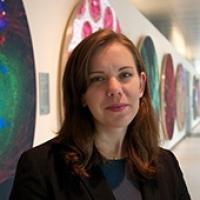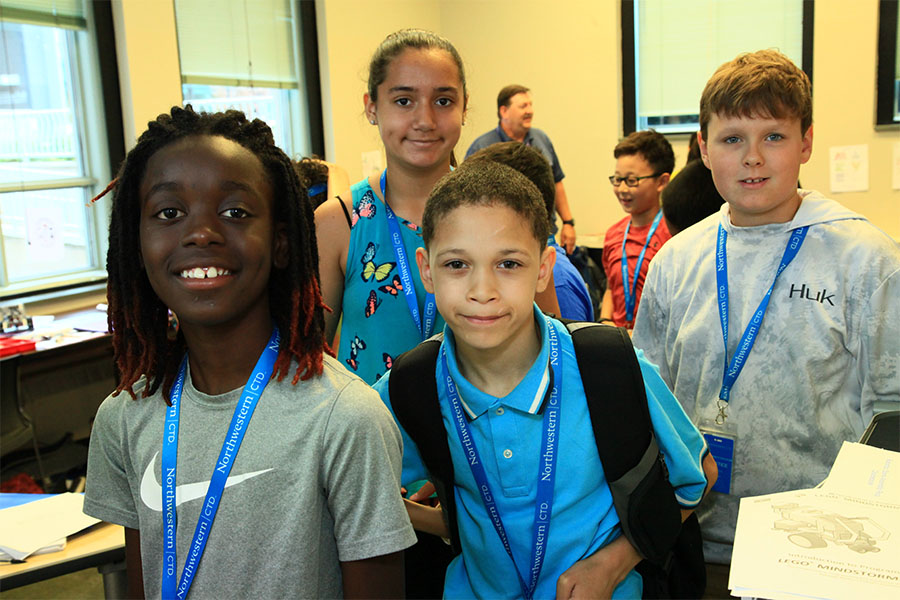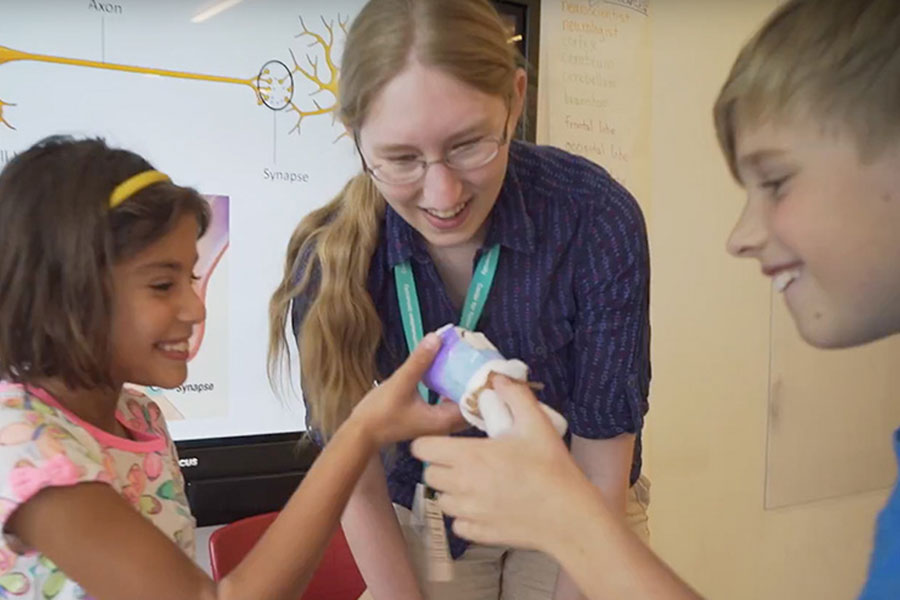CTD Associate Director Researches, Presents on Future Job Market
By Ed Finkel
How will the job market continue to develop into the future, and how can young people tailor their experiences and skills to make their market value durable and transferrable?
Center for Talent Development (CTD) Associate Director Denise Mytko, who’s also a PhD student at Lesley University in Cambridge, Massachusetts, researches those and related questions, and otherwise works at the intersection of education, labor and industry.
In her PhD work, Mytko focuses on how financially independent, non-traditional students between the ages of 18 and 25 can best answer those questions, combining her awareness of labor market trends with a passion for nurturing students’ agency, rooted in how to value, teach and measure skills that will serve them best in the long term.
 Mytko brings these same approaches to her role at CTD, where she oversees admissions, curriculum and pathways planning and outreach, and the Civic Education Project. In all her work, and particularly when developing curriculum, she creates opportunities for students to blend their unique aptitudes, interests and life goals into flexible pathway planning. In addition, Mytko has developed a popular series of presentations for parents and other youth serving adults about understanding labor market trends and planning for talent development. Mytko’s passion for education and career development is deeply rooted in her own journey as a self-sufficient 18-year-old navigating full-time work and school. She feels a strong connection to other non-traditional learners and believes their experiences offer valuable insights for the broader labor market. “I feel like that population has a lot of lessons learned to provide,” she says.
Mytko brings these same approaches to her role at CTD, where she oversees admissions, curriculum and pathways planning and outreach, and the Civic Education Project. In all her work, and particularly when developing curriculum, she creates opportunities for students to blend their unique aptitudes, interests and life goals into flexible pathway planning. In addition, Mytko has developed a popular series of presentations for parents and other youth serving adults about understanding labor market trends and planning for talent development. Mytko’s passion for education and career development is deeply rooted in her own journey as a self-sufficient 18-year-old navigating full-time work and school. She feels a strong connection to other non-traditional learners and believes their experiences offer valuable insights for the broader labor market. “I feel like that population has a lot of lessons learned to provide,” she says.
Mytko began her career in early childhood education in 1999 while earning her degree from Oakton College. Informed by her experience as an practitioner, Mytko later pursued a master’s degree at Northwestern with a focus on identifying markers of quality pathways in the early education labor market.
She then spent a decade in Boston’s tech sector, managing STEM programs and pathways at MIT, working in the field of robotics, and running a consulting business that bridged industry, education and career guidance. In 2018, she somewhat unexpectedly found herself on the path to a PhD at Lesley University.
As an associate director at CTD since 2023, Mytko has brought her diverse experiences and ongoing research to a role that aligns closely with her longstanding interests, helping to shape CTD’s future impact in talent development. When she took the role as Susan Richert Corwith was promoted to director, “Susan said, ‘There’s a lot of overlap with what you’ve done and where CTD is going,’” Mytko recalls.
Current Labor Market Trends
Among the labor market trends Mytko has tracked is the progression of automation’s integration into labor markets. “Staying aware of this relentless automation, from machine learning, to AI, to increasingly specialized collaborative robotics, is an important part of pathway planning,” she says. “Advancements in collaborative robotics that were centered in manufacturing and supply-chain management now are increasingly present in nearly all sectors of work and in our day-to-day activities.”
On a parallel track, Mytko also explores the shift away from permanent employment toward contract-based and gig work, noting its flexibility for companies but raising concerns about workers’ long-term access to stable incomes, healthcare and retirement benefits.
"For our young people, and for all of us, the ability to identify, ‘This is what I’m good at. This is how it can be used across different industries and different positions, and this is how I can use my agency and navigational capital to find (or make) a place where my skills are useful,’ is important..."
Another key focus of her research is the perceived value of “human work,” a term of art coined by Jamie Merisotis of the Lumina Foundation, referring to skills that cannot easily be automated. Mytko notes the parameters of that continue to change as automation becomes more refined. “These are skills and abilities that will help us and our children maintain the agency and efficacy needed to identify their own interests, strengths and market value independent of traditional pathways to and through the labor market,” she says.
One example of human work that she shared is the ability to investigate complex problems and bridge new concepts. “This kind of bridging, creativity, care and human-to-human connection are things that are leading the field in human work,” she says, adding that leaders across industries have told her: “We can teach the skills, or we can automate the skills, but we need people that can do these things [human work].”
Conclusions to Date
While Mytko doesn’t have final research conclusions yet, she has been making connections to non-traditional, financially independent young adults ages 18 to 25 with traits and behaviors that may be well-suited to success in the evolving labor market of the United States.
“By virtue of the situation they’re in, non-traditional students are tremendously nimble,” she says. Between financial challenges, balancing family obligations and other factors, “there are a number of external factors that can change and throw one’s intended academic pathways off track. Being able to adapt, recover, have resilience in the face of unexpected changes, and be stronger for it, is something that I see in non-traditional students, and that, I think, is really valuable.”
Mytko believes that everyone can learn from that resilience at a time when the labor market and the economy overall has become more uncertain and fast-changing. “For our young people, and for all of us, the ability to identify, ‘This is what I’m good at. This is how it can be used across different industries and different positions, and this is how I can use my agency and navigational capital to find (or make) a place where my skills are useful,’ is important,” she says.
During events at CTD and elsewhere, Mytko has been spreading this word about preparation for a changing labor market through short classes, webinars and in-person presentations. “It’s time to bring this to CTD, and I feel like we all recognize that,” she says. “There is an appetite for career readiness in schools, with teachers, with parents, and with students.”
During these events and classes, Mytko articulates how to achieve career efficacy by building a foundation of human work skills, narrative agency and awareness of aptitudes and interest, starting as early as possible. “So then, when our young people are in a labor market that we can’t really predict today, they’ll have a grounding in who they are, what they do and how they can continuously apply their skills in this new world,” she says.
In her role at CTD, Mytko feels fortunate to bring these practical workforce-preparedness skills into courses, which looks necessarily different at different points along the age spectrum. “I think our programs do a good job of that already, particularly our online program,” she says. “We’re always considering, ‘What is the voice of what we’re learning today in the labor market?’ If it’s a math class, what do mathematicians do? How do they take notes? What is their voice?’ This allows students to see how they might use class content in the future.”
To do that comprehensively, however, requires building agency and resilience, Mytko says. “The jobs we know about might not be there by the time students feel prepared to do them, so they may be making their own, new jobs using the skills that they’re learning today,” she says. “I’m very happy to do some co-curricular integrations across the disciplines of CTD. … In the Civic Education Project, we’re able to build out those human work skills with a focus on civic-mindedness, which really center on the continuous work needed to be appropriately challenged, altruistic, satisfied members of society. And there’s a wider application of those skills that we can explore across CTD.”
In doing so, Mytko counsels that students, whether planning for a non-traditional post-secondary path or in families with traditional college-pathways expectations, identify their goals carefully, but remain aware that linear planning may need to be adapted over time.
“If someone has a very rigid academic and career plan, and then gets knocked off that path, it can be very hard on them, emotionally and then also just practically,” she says. “Having students be able to see their path as something that is flexible, with potential on-ramps and off-ramps to what they would like to do, is really important.”
In thinking through how they want their life to unfold, students can’t always rely on a stable matrix labor market to move through in a predictable manner, Mytko says. “There are too many moving parts,” she says. “It can be comforting to assume that if young people take a series of prescribed steps, then everything will be fine; and everything might be fine. But we all must be ready to adapt over time to find success, satisfaction and engagement in our work. It is important to provide students with the tools and perspectives they need to adjust and ultimately achieve their desired outcomes.”

